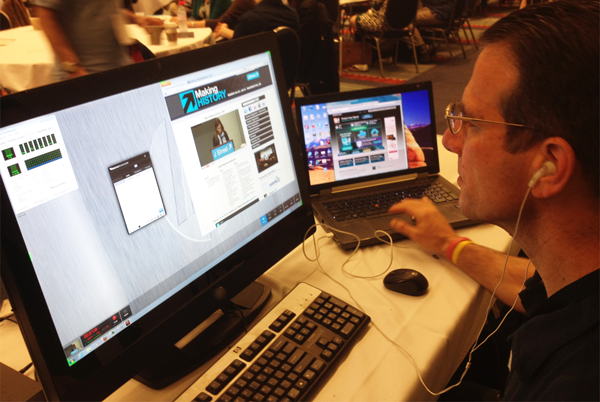Live From J Street, Part 3: Monitoring Webcast Audio
In this final segment of this series on the JStreet Making History convention webcast, we'll examine one aspect of webcast production that too often gets ignored: monitoring and controlling audio volume, which becomes a complex issue as speakers change, audio techs and shooters adjust their own levels, and the webcaster is left to make sure the signal sent over the web remains audible and consistent.
This is the final segment in a multiple-part series on webcasting JStreet.org's national convention. In this segment, I'll focus on monitoring and controlling audio volume. As you'll see, understanding how loud is loud enough is a seemingly simple problem that becomes complex once you start asking a few questions.
Overview
Let's start with your goals.
Monitor for Breaks and Other Problems
During the course of a one-hour webcast, or a series of webcasts throughout the day, your mind is going to wander. You'll check email, check stock prices, check out particularly attractive members of the audience.
If the video stops streaming when you're not staring at the screen, there's only a very small chance that you'll notice it visually. However, if you're wearing headphones, and the audio stops, you'll notice it immediately. So get in the habit of wearing your headphones throughout all sessions.
And remember to bring your headphones; in Figure 1 (below), you can see that I had to resort to my iPod earbuds because I left my headphones in Galax, and couldn't find a set of headphones in any of the truck stops I shopped at on Interstate 81.

Figure 1. Always wear your headphones when broadcasting (and remember to bring them).
Ensure Consistent Levels to Your Audience
Your web viewers can and will adjust volume at their end to ensure optimal levels. If they have to do this once, it's not a big deal. However, if they have to do it repeatedly throughout the webcast, it will be perceived as a problem. Since the client undoubtedly has folks watching the webcast online, it's a problem that reflects poorly on your work. So, one key goal is to produce consistent levels throughout the webcast.
Recognize that audio volumes change every time a different speaker approaches the microphone, whether it's on the podium or on the speakers' table. Different presenters talk at different volumes at varying distances from the microphone. So whenever there's a speaker change, you have to be ready to make a volume adjustment.
Complicating this is the possibility that there may be audio technician onsite making similar adjustments, and your shooter may be doing the same thing. So, once a speaker changes, you might adjust your levels, but then the audio tech or shooter makes their adjustments, so you have to adjust again. Bottom line is that anytime there's a change, you've got to be riding the volume sliders.
Related Articles
HP's Z1 is the first all-in-one computer with workstation components and field serviceability. Here, encoding expert Jan Ozer takes a look at how this workstation-class portable PC fared in a live production and webcast environment, with testing emphasis in 3 areas: rendering, streaming encoding, and live encoding.
Jan Ozer passes on several key tips on framing panels and applying the rule of thirds (and when to break it) gleaned from his recent gig webcasting the national J Street conference on Israeli-Palestinian relations.
During a 3-day gig as webcaster for J Street's Making History conference on Israeli-Palestinian relations, Jan Ozer learned a lot about the challenges of streaming events where you don't control critical factors like the set background and lighting. In part 1 of 3 on this project, Jan details the planning process and streaming setup.